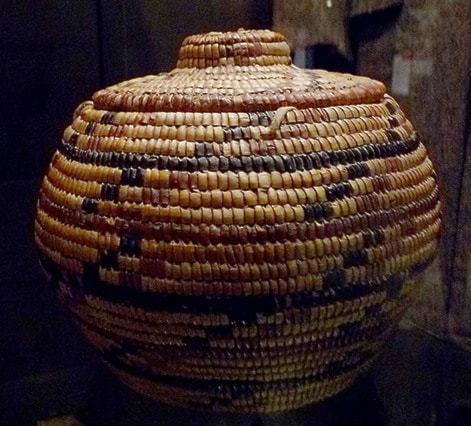The enduring tradition of basket weaving and exchange on the lower Fraser River is the focus of a revealing new exhibit at the Surrey Museum this fall.
Baskets for Barter features woven cedar baskets from the Surrey Museum’s own collection, along with historic and contemporary Coast Salish baskets from the Musqueam Indian Band, the Museum of Anthropology, the Royal B.C. Museum, New Westminster Museum and Archives and from private collections across the Lower Mainland, making it one of the most diverse exhibits of its type assembled.
The exhibit spans the centuries. There’s a 3,500-year-old basket fragment from on display (on loan from UBC’s department of archeology) – a marvel, considering how long these organic weaving remains have survived.
There are modern wonders, too, such as a colourful cellphone case made from woven cedar (pictured at left) adorning a figure draped in a dress and hat made from cedar, testament to the material’s versatility.
“The tradition is still alive and well within the community,” says Surrey Museum manager Rob McCullough, who points out that 10,000 years of knowledge, skill, tradition and culture has been passed down to the present.
The exhibit started out as an attempt to showcase the museum’s own collection of First Nations basketry, focusing on barter and trade. But those plans soon blossomed into a collaborative exhibit that’s the first of its kind for the museum, McCullough said.
McCullough said museum was the catalyst for the project, but the exhibit wouldn’t have been possible without the cooperation and collaboration of the Musqueam and Sto:lo communities.
 The museum’s basketry, he said, was acquired in an era they were classified simply as “Northwest Coast” rather than by their nations of origin – ignoring millennia of history and geographic reality.
The museum’s basketry, he said, was acquired in an era they were classified simply as “Northwest Coast” rather than by their nations of origin – ignoring millennia of history and geographic reality.
[Modern wonders like a cellphone case, left]
Setting the record straight meant reaching out to those who could help provide the answers.
Over the span of about two years, Coast Salish expert Dr. Sharon Fortney assessed 109 baskets, discovering that while many were Coast Salish in origin, others were created by Haida, Tsimshian and even Nuu-chah-nulth.
While it’s not possible to definitively identify each of the works, knowledgeable community members and experts can make strong assumptions about an object’s origins, based on design, materials and construction technique.
Living memories were accessed as well. McCullough tells the story of Howard Grant, who remembers crossing the Patullo bridge to take baskets onto a reserve in Surrey that’s no longer in use.
Another key expert was Jordan Wilson from the Musqueam Indian Band, who interviewed elders and craftspeople who are continuing the tradition of cedar weaving today.
Thanks to his work, elders and contemporary artisans are given a voice, through videos, photographs, display boards and the works themselves.
“If one was giving someone berries, it would have been in a basket – and that basket would have been kept and used by the recipient,” according to Musqueam community member Leona Sparrow, quoted in one exhibit panel.
The exhibit highlights three different spots along the river: Musqueam, located at the mouth of the Fraser, New Westminster, and the traditional territory of the Sto:lo, located upriver from Chilliwack. What’s now modern day Surrey was in the middle.
Maps are crammed with details visitors won’t easily locate elsewhere, such as names for places that have been in use for thousands of years, to places that have already vanished from contemporary parlance.
For instance, the Musqueam had several settlements in the New Westminster area, including one reserve sold in 1959.
McCollough said from 1879 to 1916, a general reserve was created in New West for the many First Nations who seasonally visited the town to work and trade.
A small reserve for Langley first nations was also located in the area, but was sold. Today, a small group of people are self-identified as the New Westminster Band.
In daily life throughout the centuries, baskets were used as containers for food and water, and were an important aspect of gift-giving at feasts, outlawed along with other traditional practices until more enlightened laws prevailed in the late 20th century.
The great skill involved in making them has been passed down through the millennia, preserving cultural traditions and knowledge that endure to this day.
Cedar bark – harvested from living western red cedar trees – makes for a versatile material.
Bark and roots can be woven into many forms, from the practical to the profound: the exhibit includes examples baby carriers, baskets used for berry collecting and storage to chairs, bottles and even tables – examples of these are also on display.
Taking such a collaborative approach is something new for the Surrey Museum, but the result was worth it.
“We’re happy they wanted to work with us,” McCullough said. “It’s starts to build bridges and create relationships.”
Without the Musqueam, he said, the exhibit’s “soul would have been missing.
–Baskets for Barter is on display to Dec. 22 at the Surrey Museum.
Follow the Cloverdale Reporter on  Twitter and
Twitter and ![]() Facebook. View our print edition online.
Facebook. View our print edition online.
